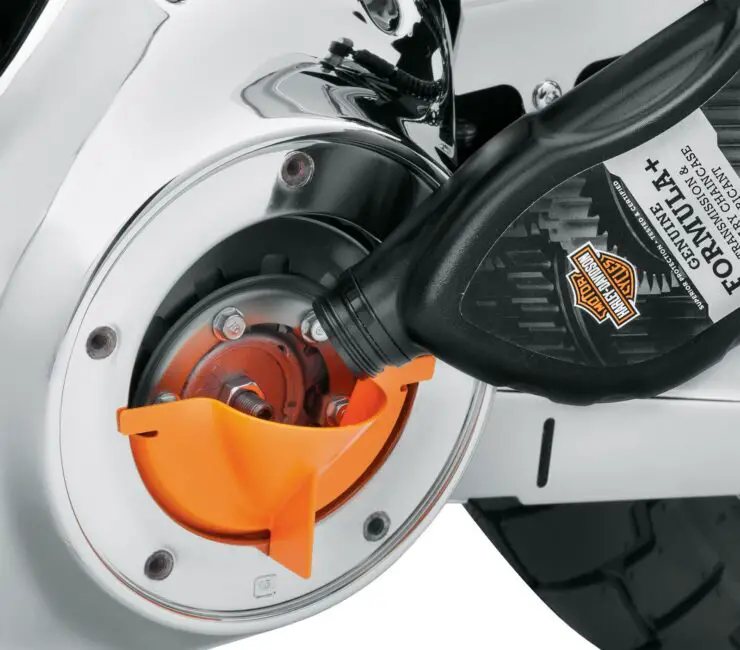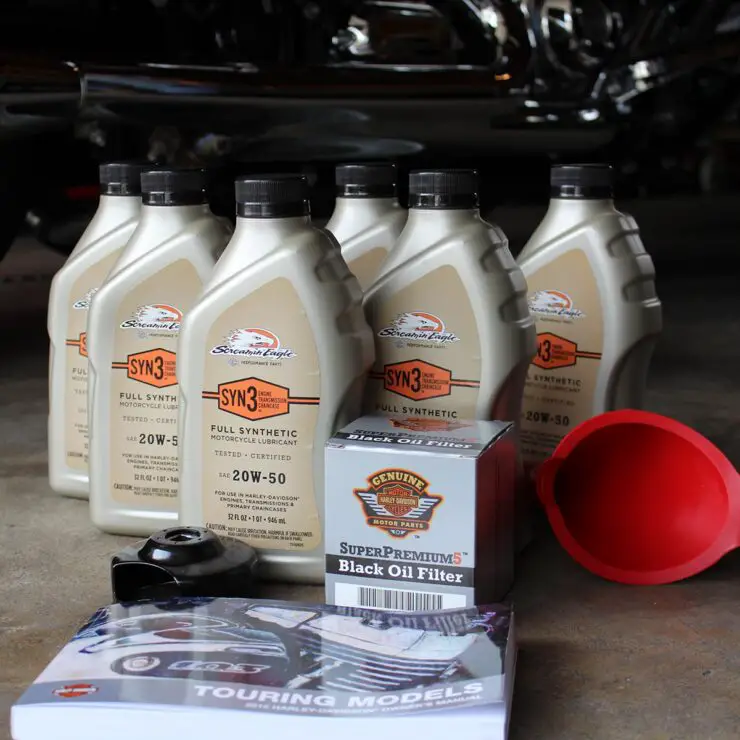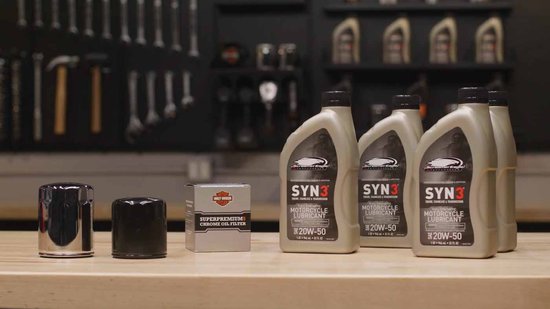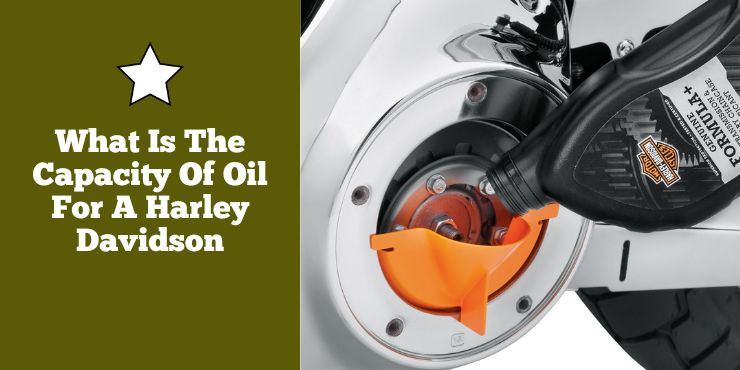Welcome Harley-Davidson enthusiasts! In this article, we’ll discuss the engine capacity of oil for a Harley-Davidson motorcycle. If you’re curious to know what type of oil is best for your Harley-Davidson, and how much oil it needs, then you’re in the right place. Let’s get started!
Harley-Davidson oil capacity varies by model, but most models require approximately 3-4 quarts of oil for the engine and 1 quart each for transmission and primary.
What is the capacity of oil for a Harley-Davidson bike?
Harley-Davidson bikes are iconic for their design, engines, and the thrilling experience they offer riders. To keep the bikes running smoothly, proper maintenance will be important. Understanding the oil capacity of your bike will be important for ensuring optimal performance and longevity.
>>> Click here to read our review of the Best Oil For Harley-Davidson <<<
Oil capacity refers to the maximum amount of oil that a bike’s engine requires for proper lubrication and cooling. It is typically measured in quarts or liters and varies depending on the make, model, and year of the bike. The correct oil capacity will ensure that the engine’s components are adequately lubricated, reducing friction and heat, and preventing premature wear and tear.
To keep your Harley-Davidson bike and its engine running smoothly and performing at its optimum best, it’ll be important to know what is the capacity of oil for a Harley-Davison bike. You need to ensure that you’re using the correct amount of oil during routine maintenance to keep your Harley running smoothly. Typically, your Harley-Davidson bike will require a little over three quarts of 20W-50 oil.
If you’re wondering what is the capacity of oil for a Harley-Davidson bike, then the answer will be approximately 3-4 quarts. The exact oil capacity for Harley-Davidson bikes will differ from model to model. The oil capacity for your Harley will be influenced by factors like the engine’s design, size, and configuration. For instance, newer Harley-Davidson models come with larger engines and might require more oil than older models that incorporated smaller engines. Moreover, certain modifications to your bike, such as adding an aftermarket oil cooler or changing the oil pan size will impact the oil capacity as well. If you’ve made modifications to your bike, it’ll be important to account for these changes when determining the ideal oil capacity.
During oil changes, it will be important that you add the correct amount of oil according to the manufacturer’s recommended capacity. Overfilling or underfilling the engine will negatively impact the bike’s performance and may even void the bike’s warranty. You must regularly check the oil level using an oil dipstick before and after each ride to make sure it falls within the recommended range. If you are noticing any significant changes in the oil level or experience oil leaks, you should promptly address the issues to prevent damage to the engine.
Benefits of knowing oil capacity for Harley-Davidson bikes
For motorcycle enthusiasts, owning a Harley-Davidson motorcycle is a dream come true. These iconic bikes are known for their power, style, and unmatched feeling of freedom that they deliver on the open road. Proper maintenance will be key to keeping your Harley-Davidson bike running at its best. Knowing the oil capacity in your bike will help you maintain your bike properly. There are numerous benefits to knowing the oil capacity of your bike and getting optimal performance and longevity from your bike.
Engine performance and efficiency
Knowing the correct oil capacity for your Harley will let you know the oil or the amount of lubrication needed by the engine to operate smoothly. Adequate lubrication reduces friction between moving engine parts, preventing premature wear and tear and increasing the engine’s efficiency. Properly lubricated components will result in a quieter and smoother-running engine, providing a more enjoyable and responsive riding experience.
Cooling and heat dissipation
Harley-Davidson bikes are known for their high-performance engines, which generate significant heat during operation. The correct oil capacity will ensure that you can provide enough oil to your bike to absorb and carry away the heat from the engine.
Effective heat dissipation will prevent overheating and potential damage to sensitive engine components, keeping your bike running at its optimal temperature.
Engine protection and longevity
Knowing the oil capacity will allow you to fill enough oil, which will be important for protecting the engine from excessive wear and damage. The oil forms a protective barrier between engine parts, reducing metal-to-metal contact, and preventing premature wear. With proper lubrication and cooling, the engine will be less likely to suffer from issues like prison scuffing, engine seizure, or premature component failure, increasing the overall longevity of your bike.
Fuel efficiency
Properly lubricated and cooled engine components greatly contribute to improved efficiency. When your bike’s engine runs smoothly and efficiently, it’ll require less effort to operate. This results in better fuel economy. Knowing the oil capacity for your Harley-Davidson bike and ensuring that it is at the correct level during regular maintenance will help you get more miles out of every tank of fuel.
Reduced maintenance costs
Regularly maintaining the correct oil level based on the recommended oil capacity will reduce the risk of engine damage and associated repair costs. By taking care of your Harley-Davidson motorcycle’s engine, you’ll be able to avoid costly repairs that might arise from inadequate lubrication, overheating, or premature wear. This proactive approach to maintenance can end up saving you money in the long run.
Peace of mind
Knowing the oil capacity for your Harley-Davidson motorcycle and keeping it at the correct level will give you peace of mind during every ride. You will be able to enjoy the open road without worrying about potential engine issues or excessive wear. When you take care of your motorcycle’s engine, you’ll be able to fully embrace the joy of riding, knowing that you’re maintaining your beloved Harley-Davidson bike to the best of your ability.

Factors that impact the oil capacity of your Harley-Davidson bike
As a Harley-Davidson biker, proper maintenance is important for preserving the performance and longevity of your bike. Among the important aspects of motorcycle maintenance will be understanding oil capacity and its impact on engine performance. There are numerous factors that play a role in determining the oil capacity of your Harley-Davidson bike.
Oil type
Choosing the right type of oil for your Harley-Davidson motorcycle will be important for its overall performance. Harley-Davidson recommends that you should use high-quality, premium oils that meet specific standards and certifications. Synthetic oils like SAE 20W-50 are commonly recommended for Harley-Davidson bikes due to their superior lubrication properties, improved heat resistance, and better flow at lower temperatures. The oil type will affect how the engine operates, how well it protects engine components, and how it withstands extreme riding conditions.
Engine performance
Harley-Davidson bikes are renowned for their powerful engines, which produce considerable heat and friction during operation. The engine’s performance directly impacts the oil’s ability to lubricate and cool the engine effectively.
High-performance engines might require more oil capacity to handle the increased stress and heat generate during spirited riding. Understanding your motorcycle’s engine performance specifications, such as compression ratio and horsepower will help determine the ideal oil capacity to support the engine’s demands.
Lubrication
Lubrication is the primary purpose of oil in a Harley-Davidson motorcycle’s engine. Oil forms a protective film between moving engine parts, reducing friction and preventing metal-to-metal contact.
Proper lubrication will ensure smooth operation and minimize wear and tear on engine components. The oil’s ability to lubricate effectively depends on its viscosity, additives, and overall quality. Maintaining the correct oil capacity will ensure that there is enough oil to provide enough lubrication for all critical engine parts.
Oil level
The oil level in the engine is an important factor in determining oil capacity. Overfilling or underfilling the engine with oil can result in performance issues and potential engine damage.
Too much oil can result in foaming and aeration, reducing the oil’s lubricating properties and potentially leading to increased wear. Meanwhile, too little oil can result in adequate lubrication and overheating. Maintaining the oil level within the recommended range will ensure optimal engine performance and prevent costly repairs.
How to change oil in Harley-Davidson motorcycles?
Changing the oil in your Harley-Davidson motorcycle is an important aspect of regular maintenance. This ensures optimal engine performance and prolongs the life of your beloved bike. With a few simple tools and the right steps, you’ll be able to confidently perform an oil change and keep your Harley running smoothly and delivering the exhilarating ride it is known for. Here are the steps you need to follow to change the oil in your Harley-Davidson bike.
Step 1: Have the right tools and supplies at your disposal
Before you start the oil change, you should gather all the tools and supplies you need. These typically include a socket wrench set, an oil filter wrench, a funnel, a new oil filter, a drain pan to catch the old oil, the correct type of oil recommended for your bike, and a replacement drain plug washer. Having everything ready and at your disposal before you start with the oil change will make the process more efficient and minimize the risk of spilling oil.
Step 2: Warm up the engine
Before you drain the old oil, you should start your Harley-Davidson motorcycle’s engine and let it run for a few minutes to warm up the oil. Warm oil tends to flow more freely and helps in removing more contaminants when draining. However, you must exercise caution and avoid touching hot engine components during this process.
Step 3: Position your bike and drain the oil
When draining the old oil, you must make sure that your Harley-Davidson bike is parked on level ground. This will allow the old oil to drain evenly and ensure accurate measurement of the oil capacity during the refill.
Locate the drain plug on the oil pan, which is typically located at the bottom of the engine. Place the drain pan beneath the drain plug and then carefully loosen the plug with a socket wrench. Once loose, you need to remove the plug by hand. This will allow the old oil to drain completely into the pan. Be extremely cautious as the oil might be hot.
Step 4: Remove the oil filter
Once you have drained the old oil, locate the oil filter on your Harley-Davidson motorcycle. Use an oil filter wrench for loosening and remove the filter. As you remove the filter, some residual oil might spill into the drain pan, so you should be prepared to catch any drips.
Step 5: Install the new oil filter
Before you install the new oil filter, lubricate the rubber gasket with a small amount of fresh oil. This will help create a better seal and prevent leaks. Carefully screw on the new oil filter by hand until it is snug. Then, give it another three-quarter to one full turn with the oil filter wrench.
Step 6: Reinstall the drain plug and add new oil
Once you have allowed the old oil to drain completely, you should reinstall the drain plug with a new drain plug washer if needed. Tighten the plug securely while being careful that you do not overtighten.
Using a funnel, you should add the recommended amount of new oil based on your Harley-Davidson motorcycle’s oil capacity. Check your bike’s owner’s manual for the specific oil capacity and type.
Step 7: Check the oil level
Once you have added the new oil, allow your bike to sit for a few minutes to allow the oil to settle. After that, check the oil level using the dipstick or oil-level sight glass. The oil level must be within the appropriate marks on the sight glass. If needed, you should add more oil to achieve the correct level.
Step 8: Clean up and dispose
Clean up any spilled oil and make sure that all components are securely tightened. Dispose of the used oil and oil filter in an environmentally responsible manner, following local regulations.

Best practices and tips to follow when changing the oil
Proper maintenance will be key to keeping your Harley performing at its best and delivering exhilarating rides. Among the essential maintenance tasks, changing the oil capacity is an important aspect. This ensures the longevity and optimal performance of your bike. To help you carry out this simple task with confidence, there are certain tips and practices to follow. Here are some of the best practices to follow for changing the oil capacity in your Harley-Davidson motorcycle.
#1. Consult the owner’s manual
One of the most important practices that you should follow is to consult your Harley-Davidson motorcycle’s owner’s manual. The owner’s manual is an incredibly valuable source of information that offers specific guidelines on the correct type of oil, oil capacity, and recommended maintenance schedule for your bike. You need to familiarize yourself with the manufacturer’s recommendations to ensure you’re using the right oil and changing it at the appropriate intervals.
#2. Use proper safety precautions
Protect yourself and your workspace during the oil change. You must wear appropriate safety gear, such as eye protection and gloves to avoid contact with hot oil or sharp components. Ensure that your workspace is well-ventilated to disperse any fumes and spills effectively.
#3. Properly dispose of old oil and filter
Dispose of the used oil and oil filter responsibly at an authorized collection entrance. Many automotive shops and recycling centers accept used oil for proper disposal and recycling. You should avoid dumping used oil in the trash or on the ground as it’ll be harmful to the environment.
#4. Double-check for leaks
After refilling the engine with fresh oil, you must double-check for any leaks around the drain plug and oil filter. You should ensure that these components are tightened securely but not overtightened as it can cause damage.
#5. Monitor oil level regularly
Once you have completed the oil change, you must monitor the oil level regularly to ensure that it remains within the recommended range. Regularly checking the oil level will help detect any potential leaks or issues, preventing more significant problems down the road.
Common questions about oil capacity
For Harley-Davidson motorcycle owners, ensuring proper oil levels will be important to maintaining optimal engine performance and prolonging the life of their beloved motorcycles. Oil plays a key role in lubricating engine components and dissipating heat, so there are a lot of questions people might have about oil capacity. Here are some of the common questions about oil capacity and their answers.
How often should I change the oil in my Harley-Davidson bike?
The frequency of oil changes for Harley-Davidson motorcycles depends on numerous factors, including the bike’s model, year, riding conditions, and oil type. As a general rule, Harley-Davidson recommends changing the oil once every 2,500 to 5,000 miles or once a year, whichever comes first. However, for high-performance models, aggressive riders, or bikes subjected to extreme riding conditions, more frequent oil changes might be necessary.

What happens if I overfill the oil?
Overfilling the oil in your Harley-Davidson motorcycle can have adverse effects on engine performance and might result in potential issues. When the oil exceeds the recommended capacity, several problems might arise.
Excess oil can cause foaming and aeration, reducing the oil’s lubricating properties. Air bubbles in the oil can result in inadequate lubrication of engine components, resulting in increased wear and potential damage.
Overfilled oil can increase pressure within the engine, resulting in oil leaks. The excess pressure can force oil past seals and gaskets, resulting in leaks that might require repairs.
The increased oil level could cause the crankshaft to dip into the oil, resulting in oil agitation and potential contact with rotating engine components. This scenario, also known as “oil windage”, can result in excessive heat and friction, resulting in engine damage.
How can I tell if I’m low on oil?
Regularly checking the oil level is important to detect if your Harley-Davidson motorcycle is low on oil. To check the oil levels, you need to make use of a dipstick or an oil-level sight glass.
Many Harley-Davidson bikes come equipped with a dipstick. With the motorcycle on level ground and the engine off, remove the dipstick, wipe it clean, and then reinsert it into the oil tank without screwing it in. Pull out the dipstick and then check the oil level. It needs to be within the recommended range indicated on the dipstick.
Some Harley-Davidson motorcycles also have an oil-level sight glass instead of a dipstick. The sight glass is located on the engine case. With your motorcycle on level ground and the engine off, you should check the oil level through the sight glass. The oil must be at the appropriate level as indicated by markings on the glass.
If you notice that the oil level is below the recommended range, it’ll be important to add the correct type and amount of oil specified in the owner’s manual to maintain proper lubrication and engine protection.
FAQ
What is the capacity of oil for a Harley-Davidson?
The capacity of oil for a Harley-Davidson varies depending on the type of motorcycle and engine. Generally, the oil capacity for a Harley-Davidson engine is between 3 and 4 quarts. It is important to use the recommended oil and oil capacity for your specific Harley-Davidson model to ensure optimal performance and engine life.
What type of oil should I use for a Harley-Davidson?
It is important to use the recommended oil type for your specific Harley-Davidson model. Generally, Harley-Davidson recommends using 20W50 oil for temperatures between 0 and 100 degrees Fahrenheit. If the temperature drops below 0 degrees Fahrenheit, 20W40 oil should be used.
What are the benefits of changing the oil for a Harley-Davidson?
Regular oil changes provide several benefits for a Harley-Davidson, including improved engine performance, reduced wear and tear, and improved fuel economy. It is important to follow the recommended oil change interval for your Harley-Davidson model to ensure optimal performance and engine life.
>>> Read more about Oil for Harley-Davidson <<<

